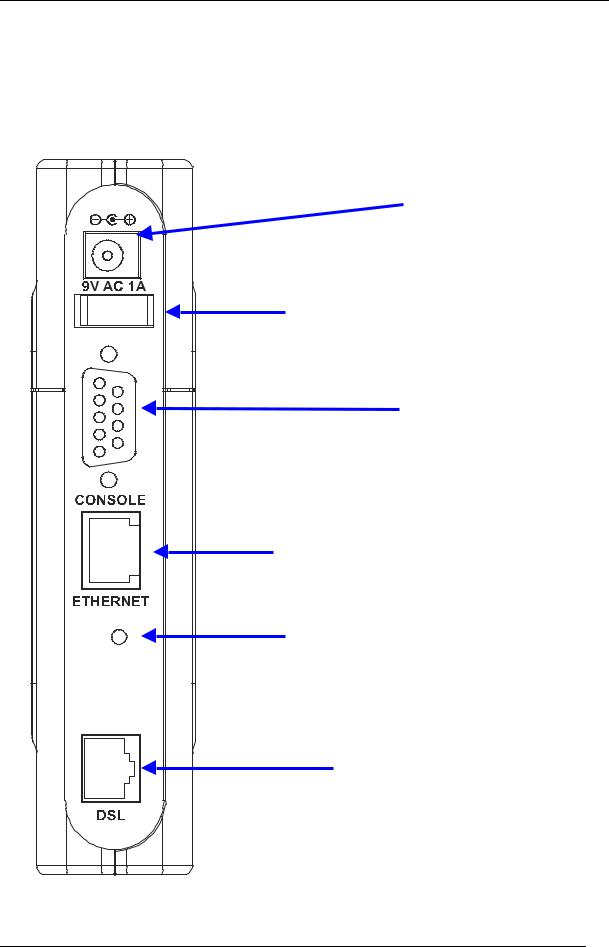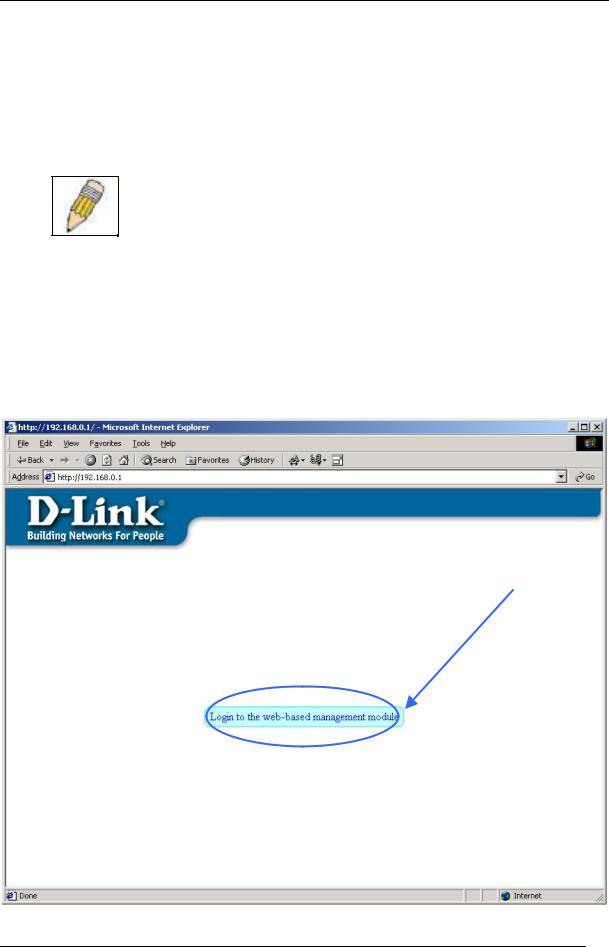D-Link DSL-1500G User Manual

DSL-1500G
SHDSLRouter
User’s Guide
First Edition (July 2003)

DSL-1500G SHDSL Ethernet Router User’s Guide
Wichtige Sicherheitshinweise
1.Bitte lesen Sie sich diese Hinweise sorgfältig durch.
2.Heben Sie diese Anleitung für den spätern Gebrauch auf.
3.Vor jedem Reinigen ist das Gerät vom Stromnetz zu trennen. Vervenden Sie keine Flüssigoder Aerosolreiniger. Am besten dient ein angefeuchtetes Tuch zur Reinigung.
4.Um eine Beschädigung des Gerätes zu vermeiden sollten Sie nur Zubehörteile verwenden, die vom Hersteller zugelassen sind.
5.Das Gerät is vor Feuchtigkeit zu schützen.
6.Bei der Aufstellung des Gerätes ist auf sichern Stand zu achten. Ein Kippen oder Fallen könnte Verletzungen hervorrufen. Verwenden Sie nur sichere Standorte und beachten Sie die Aufstellhinweise des Herstellers.
7.Die Belüftungsöffnungen dienen zur Luftzirkulation die das Gerät vor Überhitzung schützt. Sorgen Sie dafür, daß diese Öffnungen nicht abgedeckt werden.
8.Beachten Sie beim Anschluß an das Stromnetz die Anschlußwerte.
9.Die Netzanschlußsteckdose muß aus Gründen der elektrischen Sicherheit einen Schutzleiterkontakt haben.
10.Verlegen Sie die Netzanschlußleitung so, daß niemand darüber fallen kann. Es sollete auch nichts auf der Leitung abgestellt werden.
11.Alle Hinweise und Warnungen die sich am Geräten befinden sind zu beachten.
12.Wird das Gerät über einen längeren Zeitraum nicht benutzt, sollten Sie es vom Stromnetz trennen. Somit wird im Falle einer Überspannung eine Beschädigung vermieden.
13.Durch die Lüftungsöffnungen dürfen niemals Gegenstände oder Flüssigkeiten in das Gerät gelangen. Dies könnte einen Brand bzw. Elektrischen Schlag auslösen.
14.Öffnen Sie niemals das Gerät. Das Gerät darf aus Gründen der elektrischen Sicherheit nur von authorisiertem Servicepersonal geöffnet werden.
15.Wenn folgende Situationen auftreten ist das Gerät vom Stromnetz zu trennen und von einer qualifizierten Servicestelle zu überprüfen:
a – Netzkabel oder Netzstecker sint beschädigt. b – Flüssigkeit ist in das Gerät eingedrungen. c – Das Gerät war Feuchtigkeit ausgesetzt.
d – Wenn das Gerät nicht der Bedienungsanleitung ensprechend funktioniert oder Sie mit Hilfe dieser Anleitung keine Verbesserung erzielen.
e – Das Gerät ist gefallen und/oder das Gehäuse ist beschädigt.
f – Wenn das Gerät deutliche Anzeichen eines Defektes aufweist.
16.Bei Reparaturen dürfen nur Orginalersatzteile bzw. den Orginalteilen entsprechende Teile verwendet werden. Der Einsatz von ungeeigneten Ersatzteilen kann eine weitere Beschädigung hervorrufen.
17.Wenden Sie sich mit allen Fragen die Service und Repartur betreffen an Ihren Servicepartner. Somit stellen Sie die Betriebssicherheit des Gerätes sicher.
18.Zum Netzanschluß dieses Gerätes ist eine geprüfte Leitung zu verwenden, Für einen Nennstrom bis 6A und einem Gerätegewicht großer 3kg ist eine Leitung nicht leichter als H05VV-F, 3G, 0.75mm2 einzusetzen
ii

DSL-1500G SHDSL Ethernet Router User’s Guide
Limited Warranty
Hardware:
D-LINK WARRANTS EACH OF ITS HARDWARE PRODUCTS TO BE FREE FROM DEFECTS IN WORKMANSHIP AND MATERIALS UNDER NORMAL USE AND SERVICE FOR A PERIOD COMMENCING ON THE DATE OF PURCHASE FROM D- LINK OR ITS AUTHORIZED RESELLER AND EXTENDING FOR THE LENGTH OF TIME STIPULATED BY THE AUTHORIZED RESELLER OR D-LINK BRANCH OFFICE NEAREST TO THE PLACE OF PURCHASE.
THIS WARRANTY APPLIES ON THE CONDITION THAT THE PRODUCT REGISTRATION CARD IS FILLED OUT AND RETURNED TO A D-LINK OFFICE WITHIN NINETY (90) DAYS OF PURCHASE. A LIST OF D-LINK OFFICES IS PROVIDED AT THE BACK OF THIS MANUAL, TOGETHER WITH A COPY OF THE REGISTRATION CARD.
IF THE PRODUCT PROVES DEFECTIVE WITHIN THE APPLICABLE WARRANTY PERIOD, D-LINK WILL PROVIDE REPAIR OR REPLACEMENT OF THE PRODUCT. D-LINK SHALL HAVE THE SOLE DISCRETION WHETHER TO REPAIR OR REPLACE, AND REPLACEMENT PRODUCT MAY BE NEW OR RECONDITIONED. REPLACEMENT PRODUCT SHALL BE OF EQUIVALENT OR BETTER SPECIFICATIONS, RELATIVE TO THE DEFECTIVE PRODUCT, BUT NEED NOT BE IDENTICAL. ANY PRODUCT OR PART REPAIRED BY D-LINK PURSUANT TO THIS WARRANTY SHALL HAVE A WARRANTY PERIOD OF NOT LESS THAN 90 DAYS, FROM DATE OF SUCH REPAIR, IRRESPECTIVE OF ANY EARLIER EXPIRATION OF ORIGINAL WARRANTY PERIOD. WHEN D-LINK PROVIDES REPLACEMENT, THEN THE DEFECTIVE PRODUCT BECOMES THE PROPERTY OF D-LINK.
WARRANTY SERVICE MAY BE OBTAINED BY CONTACTING A D-LINK OFFICE WITHIN THE APPLICABLE WARRANTY PERIOD, AND REQUESTING A RETURN MATERIAL AUTHORIZATION (RMA) NUMBER. IF A REGISTRATION CARD FOR THE PRODUCT IN QUESTION HAS NOT BEEN RETURNED TO D-LINK, THEN A PROOF OF PURCHASE (SUCH AS A COPY OF THE DATED PURCHASE INVOICE) MUST BE PROVIDED. IF PURCHASER'S CIRCUMSTANCES REQUIRE SPECIAL HANDLING OF WARRANTY CORRECTION, THEN AT THE TIME OF REQUESTING RMA NUMBER, PURCHASER MAY ALSO PROPOSE SPECIAL PROCEDURE AS MAY BE SUITABLE TO THE CASE.
AFTER AN RMA NUMBER IS ISSUED, THE DEFECTIVE PRODUCT MUST BE PACKAGED SECURELY IN THE ORIGINAL OR OTHER SUITABLE SHIPPING PACKAGE TO ENSURE THAT IT WILL NOT BE DAMAGED IN TRANSIT, AND THE RMA NUMBER MUST BE PROMINENTLY MARKED ON THE OUTSIDE OF THE PACKAGE. THE PACKAGE MUST BE MAILED OR OTHERWISE SHIPPED TO D-LINK WITH ALL COSTS OF MAILING/SHIPPING/INSURANCE PREPAID. D-LINK SHALL NEVER BE RESPONSIBLE FOR ANY SOFTWARE, FIRMWARE, INFORMATION, OR MEMORY DATA OF PURCHASER CONTAINED IN, STORED ON, OR INTEGRATED WITH ANY PRODUCT RETURNED TO D-LINK PURSUANT TO THIS WARRANTY.
ANY PACKAGE RETURNED TO D-LINK WITHOUT AN RMA NUMBER WILL BE REJECTED AND SHIPPED BACK TO PURCHASER AT PURCHASER'S EXPENSE, AND D-LINK RESERVES THE RIGHT IN SUCH A CASE TO LEVY A REASONABLE HANDLING CHARGE IN ADDITION MAILING OR SHIPPING COSTS.
Software:
WARRANTY SERVICE FOR SOFTWARE PRODUCTS MAY BE OBTAINED BY CONTACTING A D-LINK OFFICE WITHIN THE APPLICABLE WARRANTY PERIOD. A LIST OF D-LINK OFFICES IS PROVIDED AT THE BACK OF THIS MANUAL, TOGETHER WITH A COPY OF THE REGISTRATION CARD. IF A REGISTRATION CARD FOR THE PRODUCT IN QUESTION HAS NOT BEEN RETURNED TO A D-LINK OFFICE, THEN A PROOF OF PURCHASE (SUCH AS A COPY OF THE DATED PURCHASE INVOICE) MUST BE PROVIDED WHEN REQUESTING WARRANTY SERVICE. THE TERM "PURCHASE" IN THIS SOFTWARE WARRANTY REFERS TO THE PURCHASE TRANSACTION AND RESULTING LICENSE TO USE SUCH SOFTWARE.
D-LINK WARRANTS THAT ITS SOFTWARE PRODUCTS WILL PERFORM IN SUBSTANTIAL CONFORMANCE WITH THE APPLICABLE PRODUCT DOCUMENTATION PROVIDED BY D-LINK WITH SUCH SOFTWARE PRODUCT, FOR A PERIOD OF NINETY (90) DAYS FROM THE DATE OF PURCHASE FROM D-LINK OR ITS AUTHORIZED RESELLER. D-LINK WARRANTS THE MAGNETIC MEDIA, ON WHICH D-LINK PROVIDES ITS SOFTWARE PRODUCT, AGAINST FAILURE DURING THE SAME WARRANTY PERIOD. THIS WARRANTY APPLIES TO PURCHASED SOFTWARE, AND TO REPLACEMENT SOFTWARE PROVIDED BY D-LINK PURSUANT TO THIS WARRANTY, BUT SHALL NOT APPLY TO ANY UPDATE OR REPLACEMENT WHICH MAY BE PROVIDED FOR DOWNLOAD VIA THE INTERNET, OR TO ANY UPDATE WHICH MAY OTHERWISE BE PROVIDED FREE OF CHARGE.
D-LINK'S SOLE OBLIGATION UNDER THIS SOFTWARE WARRANTY SHALL BE TO REPLACE ANY DEFECTIVE SOFTWARE PRODUCT WITH PRODUCT WHICH SUBSTANTIALLY CONFORMS TO D-LINK'S APPLICABLE PRODUCT DOCUMENTATION. PURCHASER ASSUMES RESPONSIBILITY FOR THE SELECTION OF APPROPRIATE APPLICATION AND SYSTEM/PLATFORM SOFTWARE AND ASSOCIATED REFERENCE MATERIALS. D-LINK MAKES NO WARRANTY THAT ITS SOFTWARE PRODUCTS WILL WORK IN COMBINATION WITH ANY HARDWARE, OR ANY APPLICATION OR SYSTEM/PLATFORM SOFTWARE PRODUCT PROVIDED BY ANY THIRD PARTY, EXCEPTING ONLY SUCH PRODUCTS AS ARE EXPRESSLY REPRESENTED, IN D-LINK'S APPLICABLE PRODUCT DOCUMENTATION AS BEING COMPATIBLE. D- LINK'S OBLIGATION UNDER THIS WARRANTY SHALL BE A REASONABLE EFFORT TO PROVIDE COMPATIBILITY, BUT D- LINK SHALL HAVE NO OBLIGATION TO PROVIDE COMPATIBILITY WHEN THERE IS FAULT IN THE THIRD-PARTY HARDWARE OR SOFTWARE. D-LINK MAKES NO WARRANTY THAT OPERATION OF ITS SOFTWARE PRODUCTS WILL BE UNINTERRUPTED OR ABSOLUTELY ERROR-FREE, AND NO WARRANTY THAT ALL DEFECTS IN THE SOFTWARE PRODUCT, WITHIN OR WITHOUT THE SCOPE OF D-LINK'S APPLICABLE PRODUCT DOCUMENTATION, WILL BE CORRECTED.
D-Link Offices for Registration and Warranty Service
THE PRODUCT'S REGISTRATION CARD, PROVIDED AT THE BACK OF THIS MANUAL, MUST BE SENT TO A D-LINK OFFICE. TO OBTAIN AN RMA NUMBER FOR WARRANTY SERVICE AS TO A HARDWARE PRODUCT, OR TO OBTAIN WARRANTY SERVICE AS TO A SOFTWARE PRODUCT, CONTACT THE D-LINK OFFICE NEAREST YOU. AN ADDRESS/TELEPHONE/FAX/E-MAIL/WEB SITE LIST OF D-LINK OFFICES IS PROVIDED IN THE BACK OF THIS MANUAL.
iii

DSL-1500G SHDSL Ethernet Router User’s Guide
LIMITATION OF WARRANTIES
IF THE D-LINK PRODUCT DOES NOT OPERATE AS WARRANTED ABOVE, THE CUSTOMER'S SOLE REMEDY SHALL BE, AT D-LINK'S OPTION, REPAIR OR REPLACEMENT. THE FOREGOING WARRANTIES AND REMEDIES ARE EXCLUSIVE AND ARE IN LIEU OF ALL OTHER WARRANTIES, EXPRESSED OR IMPLIED, EITHER IN FACT OR BY OPERATION OF LAW, STATUTORY OR OTHERWISE, INCLUDING WARRANTIES OF MERCHANTABILITY AND FITNESS FOR A PARTICULAR PURPOSE. D-LINK NEITHER ASSUMES NOR AUTHORIZES ANY OTHER PERSON TO ASSUME FOR IT ANY OTHER LIABILITY IN CONNECTION WITH THE SALE, INSTALLATION MAINTENANCE OR USE OF D-LINK'S PRODUCTS
D-LINK SHALL NOT BE LIABLE UNDER THIS WARRANTY IF ITS TESTING AND EXAMINATION DISCLOSE THAT THE ALLEGED DEFECT IN THE PRODUCT DOES NOT EXIST OR WAS CAUSED BY THE CUSTOMER'S OR ANY THIRD PERSON'S MISUSE, NEGLECT, IMPROPER INSTALLATION OR TESTING, UNAUTHORIZED ATTEMPTS TO REPAIR, OR ANY OTHER CAUSE BEYOND THE RANGE OF THE INTENDED USE, OR BY ACCIDENT, FIRE, LIGHTNING OR OTHER HAZARD.
LIMITATION OF LIABILITY
IN NO EVENT WILL D-LINK BE LIABLE FOR ANY DAMAGES, INCLUDING LOSS OF DATA, LOSS OF PROFITS, COST OF COVER OR OTHER INCIDENTAL, CONSEQUENTIAL OR INDIRECT DAMAGES ARISING OUT THE INSTALLATION, MAINTENANCE, USE, PERFORMANCE, FAILURE OR INTERRUPTION OF A D- LINK PRODUCT, HOWEVER CAUSED AND ON ANY THEORY OF LIABILITY. THIS LIMITATION WILL APPLY EVEN IF D-LINK HAS BEEN ADVISED OF THE POSSIBILITY OF SUCH DAMAGE.
IF YOU PURCHASED A D-LINK PRODUCT IN THE UNITED STATES, SOME STATES DO NOT ALLOW THE LIMITATION OR EXCLUSION OF LIABILITY FOR INCIDENTAL OR CONSEQUENTIAL DAMAGES, SO THE ABOVE LIMITATION MAY NOT APPLY TO YOU.
Trademarks
Copyright 2000 D-Link Corporation. Contents subject to change without prior notice.
D-Link is a registered trademark of D-Link Corporation/D-Link Systems, Inc. All other trademarks belong to their respective proprietors.
Copyright Statement
No part of this publication may be reproduced in any form or by any means or used to make any derivative such as translation, transformation, or adaptation without permission from D-Link Corporation/D-Link Systems Inc., as stipulated by the United States Copyright Act of 1976
FCC Warning
This device complies with part 15 of the FCC Rules. Operation is subject to the following two conditions: (1) This device may not cause harmful interference, and (2) this device must accept any interference received, including interference that may cause undesired operation.
This equipment has been tested and found to comply with the limits for a Class B digital device, pursuant to part 15 of the FCC Rules. These limits are designed to provide reasonable protection against harmful interference in a residential installation. This generates, uses and can radiate radio frequency energy and, if not installed and used in accordance with the instructions, may cause harmful interference to radio communications. However, there is no guarantee that interference will not occur in a particular installation. If this equipment does cause harmful interference to radio or television reception, which can be determined by turning equipment off and on, the user is encouraged to try to correct the interference by one or more of the following measures:
-Reorient or relocate the receiving antenna.
-Increase the separation between the equipment and receiver.
-Connect the equipment into an outlet on a circuit different from that to which the receiver is connected.
-Consult the dealer or an experienced radio/TV technician for help.
CE Mark Warning
This is a Class B product. In a domestic environment, this product may cause radio interference in which case the user may be required to take adequate measures.
iv

|
TABLE OF CONTENTS |
Limited Warranty........................................................................................................................................... |
iii |
ABOUT THIS GUIDE................................................................................................ |
VII |
Guide Overview ............................................................................................................................................ |
vii |
Before You Start ............................................................................................................................................... |
vii |
Requirements for Installation....................................................................................................................... |
viii |
Packing List ................................................................................................................................................... |
ix |
INTRODUCTION ........................................................................................................ |
1 |
Product Features.................................................................................................................................................. |
2 |
Standards Compatibility and Compliance........................................................................................................... |
3 |
Front Panel LED Display.................................................................................................................................... |
4 |
Rear Panel Cable Connections ............................................................................................................................ |
5 |
HARDWARE INSTALLATION .................................................................................... |
6 |
Connect Router to Ethernet................................................................................................................................. |
6 |
Power On Router............................................................................................................................................. |
6 |
Factory Reset Button....................................................................................................................................... |
6 |
CONFIGURING THE ROUTER FOR THE FIRST TIME ............................................ |
7 |
Step 1 - Configure IP Settings on Your Computer.............................................................................................. |
7 |
Step 2 - Access the Configuration Manager....................................................................................................... |
9 |
Step 3 - Configure the Router ........................................................................................................................... |
11 |
WEB-BASED MANAGEMENT GUIDE ...................................................................... |
13 |
Accessing the Web Manager......................................................................................................................... |
13 |
Router Configuration ........................................................................................................................................ |
15 |
Router/Bridge Configuration ........................................................................................................................ |
15 |
Adding and Changing Connection Profiles................................................................................................... |
19 |
Configuring LAN IP Settings........................................................................................................................ |
22 |
Proxy DNS Settings ...................................................................................................................................... |
23 |
DHCP Configuration..................................................................................................................................... |
24 |
NAT Configuration ....................................................................................................................................... |
25 |
Port Redirection ............................................................................................................................................ |
28 |
Static Route Configuration............................................................................................................................ |
30 |
Advanced Filter & Firewall .......................................................................................................................... |
31 |
RIP ................................................................................................................................................................ |
33 |
Date & Time Settings.................................................................................................................................... |
34 |
UPnP ............................................................................................................................................................. |
35 |
System Maintenance ......................................................................................................................................... |
36 |

System Username and Password................................................................................................................... |
37 |
Save Changes ................................................................................................................................................ |
37 |
Factory Reset................................................................................................................................................. |
38 |
Update Firmware........................................................................................................................................... |
38 |
Configuration File Maintenance.................................................................................................................... |
39 |
Remote Administration Access..................................................................................................................... |
39 |
Summary ........................................................................................................................................................... |
41 |
DHCP Allocation Table ................................................................................................................................ |
43 |
Port Redirection Summary............................................................................................................................ |
43 |
Runtime Routing Table................................................................................................................................. |
44 |
Filter and Firewall Summary ........................................................................................................................ |
44 |
TECHNICAL SPECIFICATIONS ............................................................................... |
46 |

DSL-1500G SHDSL Ethernet Router User’s Guide
About This Guide
Thank you for choosing the DSL-1500G Wireless SHDSL Router. The DSL-1500G delivers affordable T1 equivalent Internet access characterized by very high rate upload and downloads data transmission speeds. The standardized SHDSL technology implemented in the Router is ideally suited for VPN applications, video teleconferencing, IP telephony applications, public web servers and interactive gaming over the Internet. The reliable high-capacity Router can serve as the primary gateway device for busy corporate networks, improving network efficiency and enhanced security.
If you would like to set up the device quickly in order to verify that the SHDSL connection to the WAN (wide area network) is working properly, please read the Quick Installation Guide included in the DSL-1500G package.
Some basic information about Ethernet LAN, networking devices, gateway routers and the TCP/IP suite of protocols is provided in the text of this guide. If you would like to learn more about home or small office networking D-Link has tutorials available at:
http://www.dlink.com/learnbasic/ and http://www.dlink.com/learnbasic/homenetwork/.
Guide Overview
Introduction – Describes the Router and its key features. Provides an introduction to SHDSL. Lists standards to which the Router complies. Contains a packing list.
Hardware Installation – Discusses how to connect the Router to an Ethernet LAN.
Configuring the Router for the First Time – Provides information on how to configure the Router and establish the WAN connection using the web-based manager.
Web-based Configuration – Describes how to use the web-based manager to change Router settings and configure additional virtual connections (PVCs).
Appendix A - Technical Specifications – Lists the technical specifications of the Router, including standards compliance.
Before You Start
Please read and make sure you understand all the prerequisites for proper installation of your new Router. Have all the necessary information and equipment on hand before beginning the installation.
vii

DSL-1500G SHDSL Ethernet Router User’s Guide
Installation Overview
The procedure to install the Router can be described in general terms in the following steps:
1.Gather information and equipment needed to install the device. Before you begin the actual installation make sure you have all the necessary information and equipment. Check the contents of the package to be certain that everything listed on the packing list is included. A packing list is included at the end of this section. The information you will need includes the account name or number and the password used to gain access to your service provider’s network, and ultimately to the Internet. In addition, some users may be given information used to configure the Router so it can establish a connection to the service provider’s network and the Internet.
2.Install the hardware, that is, connect the Ethernet and telephone cables to the device to establish the necessary network links to your computer and to the service provider’s network and connect the power adapter to power on the Router.
3.Check the IP settings on your computer and change them if necessary so the computer can access the web-based software built into the Router. Without the correct IP settings your computer will not be able to communicate with the ddevice or access the software used to configure the Router. Without compatible IP settings on your computer, you will not be able to use a web browser to access the Internet.
4.Use the web-based management software to configure the device to suit the requirements of your SHDSL account as instructed by your service provider. Some users may not need to change any of the device settings that establish and maintain the network connection. It may only be necessary to supply the user name or number and the password used for your account. Other users may not be required to change anything in the Router but they may need to install software on a computer used to access the Internet. Follow the instructions of your service provider to find out what is required for your account.
Requirements for Installation
In order to use SHDSL you must have SHDSL service set up by your service provider. SHDSL operates on a separate physical line from normal voice telephone service therefore you must have a line dedicated for SHDSL in addition to your regular telephone line.
To install and use the Router you need a computer equipped with an Ethernet port (such as an Ethernet NIC) and a web browser. To establish the WAN connection to your ISP’s network, it will be necessary for most users to make some changes to the WAN configuration of the Router. This change may only be to supply a user name and password for your ISP account (see below).
Operating System
The Router uses an HTML-based web interface for setup and management. The web configuration manager may be accessed using any operating system capable of running web browser software.
Web Browser
Any common web browser can be used to configure the Router using the web configuration management software. The program is designed to work best with more recently released browsers such as Microsoft Internet Explorer® version 5.0, Netscape Navigator® version 4.7, or later versions. The web browser must have JavaScript enabled. JavaScript is enabled by default on many browsers. Make sure JavaScript has not been disabled by other software (such as virus protection or web user security packages) that may be running on your computer.
Ethernet Port (NIC Adapter)
Any computer that uses the Router must be able to connect to it through the Ethernet port on the Router. This connection is an Ethernet connection and therefore requires that your computer be equipped with an Ethernet port as well. Most notebook computers are now sold with an Ethernet port already installed. Likewise, most fully assembled desktop computers come with an Ethernet NIC adapter as standard equipment. If your computer does not have an Ethernet port, you must install an Ethernet NIC adapter before you can use the Router. If you must install an adapter, follow the installation instructions that come with the Ethernet NIC adapter.
viii

DSL-1500G SHDSL Ethernet Router User’s Guide
Account Information (User Name and Password)
Most users will need to supply a user name and password used to access the service provider’s network (and ultimately, the Internet). This information is stored either in the Router’s memory or on your computer depending on the type of SHDSL connection profile (encapsulation method) you have.
ISP ACCOUNT INFORMATION
User Name:
Password:
Packing List
Open the shipping carton and carefully remove all items. Make sure that you have the items listed here.
1.One DSL-1500G SHDSL Ethernet Router
2.One CD-ROM containing the User’s Guide
3.One twisted-pair telephone cable used for SHDSL connection
4.One straight-through Ethernet cable
5.One AC power adapter suitable for your electric service
ix

DSL-1500G SHDSL Ethernet Router User’s Guide
1
Introduction
This chapter describes the Router and it features and includes brief introduction to SHDSL. Front and rear panel diagrams are used to illustrate the LED indicators and cable connections.
Router Description and Operation
The DSL-1500G SHDSL Router is designed as a gateway for busy networks. It provides upload and download speeds of up to 2.3 Mbps. High speed symmetrical data transmission is ideally suited to business networks using VPN and remote LAN-to-LAN applications, video teleconferencing, web servers, IP telephony and Internet gaming.
The Router is easy to install and use. The DSL-1500G connects to an Ethernet LAN via a standard Ethernet 10BASE-T interface using RJ-45 connectors. The SHDSL connection is made using ordinary twisted-pair telephone line with standard RJ-11 connectors. Enhanced 4-wire SHDSL service requires a special installation. (Ask your service provider about the availability of 4-wire SHDSL service).
Enterprise-grade features on the DSL-1500G provide security, efficiency and reliability for demanding business networks. The Router supports transparent bridging or it can be used for IP packet routing over the Internet. Cost saving features of the Router such as NAT (Network Address Translator) and DHCP (Dynamic Host Configuration Protocol) improve efficiency and security. The advanced security enhancements, packet filtering and port redirection, can help protect your network from potentially devastating intrusions by malicious agents from outside your network.
About SHDSL
Symmetric High-Speed Digital Subscriber Line technology is the first international DSL standard developed from the ground up. It represents a very significant improvement over the interim SDSL standard, delivering higher bit rates over longer distances. SHDSL allows telecommunications companies to deliver T1-level data network services at fraction of the cost. The standard has been developed by the International Telecommunications Union (ITU) in Geneva Switzerland with cooperation and input from a consortium of telecommunications and computer technology industry leaders.
It is important to note that SHDSL does not support analog splitting technologies and therefore cannot coexist with regular voice telephone service or ISDN installations. Unlike Asymmetric Digital Subscriber Line (ADSL) technology, SHDSL requires a separate dedicated physical line (standard twisted-pair copper telephone wire). Plain Old Telephone Services (POTS) cannot share the same line with SHDSL, although IP phones can be used over SHDSL. The standard also allows for extended reach double twisted-pair (4-wire) implementations that can double the bandwidth to up to 4.6 Mbps upstream and downstream.
1

DSL-1500G SHDSL Ethernet Router User’s Guide
Product Features
The DSL-1500G SHDSL Router utilizes the latest DSL enhancements and router technologies to provide a robust Internet gateway suitable for most small to medium sized networks.
VPN Support
The DSL-1500G SHDSL supports VPN Pass Through for L2TP, PPTP and IP Sec.
Firewall Protection
Tailored firewall security features include packet filtering for protocol and IP address and port redirection.
DHCP Support (Dynamic Host Configuration Protocol)
DHCP (Dynamic Host Configuration Protocol) automatically and dynamically assigns al LAN IP settings to each host on your network. This eliminates the need to reconfigure every host whenever changes in network topology occur.
Network Address Translation (NAT)
For small and medium office networks, the DSL-1500G allows multiple users on the LAN to access the Internet concurrently through a single IP address. This provides Internet access to every workstation using a single Internet account.
NAT improves network security in effect by hiding the private network behind one global and visible IP address. NAT address mapping can also be used to link two IP domains via a LAN-to-LAN connection for remote LAN implementations.
Static Routing
This allows you to select a data path to a particular network destination that will remain in the routing table and never “age out”. If you wish to define a specific route that will always be used for data traffic from your LAN to a specific destination within your LAN (for example to another router or a server) or outside your network (to a ISP defined default gateway for instance).
Multiple Encapsulation Support
The DSL-1500G supports Bridged Ethernet over ATM (RFC2684), IP over ATM (RFC1577) and PPP over ATM (RFC 2364).
Precise ATM Traffic Shaping
Traffic shaping is a method of controlling the flow rate of ATM data cells. This function helps to establish the Quality of Service for ATM data transfer.
High Performance
Very high symmetric data transfer rates of up to 2.3 Mbps Upstream/Downstream over standard single twistedpair telephone cable. Up to 4.6 Mbps Upstream/Downstream is possible for double twisted-pair installations.
Full Network Management
The DSL-1500G incorporates SNMP (Simple Network Management Protocol) support for web-based management and text-based network management via an RS-232 or Telnet connection. Enable Telnet for remote text-based management access to the Router. Management through the WAN port can be enabled for access from outside the LAN.
Easy Installation
The DSL-1500G uses a web-based graphical user interface program for convenient management access and easy set up. Any common web browser software can be used to manage the Router
2

DSL-1500G SHDSL Ethernet Router User’s Guide
Standards Compatibility and Compliance
The DSL-1500G complies with or is compatible with the following standards as recognized by their respective agencies.
•ITU G.991.2 SHDSL compliant
•RFC 1483 Multi-protocol over ATM “Bridged Ethernet” compliant
•RFC 2364 PPP over ATM compliant
•RFC 2516 PPP over Ethernet compliant
•RFC 1334 PPP Authentication Protocol compliant
•RFC 1994 Challenge Handshake Authentication Protocol compliant
•RFC 791 Internet Protocol compliant
•RFC 826 Address Resolution Protocol compliant
•RFC 950 Internet Control Message Protocol compliant
•RFC 1631 Net Address Translator compliant
•Supports RFC 2131 and RFC 2132 DHCP functions including: automatic assignment of IP address, use of subnet mask and default gateway and provision of DNS server address for all hosts
•IEEE 802.3 compliant
•IEEE 802.3u compliant
•Supports RIP v1 and RIP v2
•Supports Static Routing
•Minimum ATM cell forwarding rate: 320 Kbps
3

DSL-1500G SHDSL Ethernet Router User’s Guide
Front Panel LED Display
Place the Router in a location that permits an easy view of the LED indicators on the front panel.
The LED indicators on the front panel include the Power, Status, SHDSL Link/Activity, and WLAN indicators. Each Ethernet LAN port displays a pair of indicators for monitoring connection speed (10M/100M), link status and activity (Link/Act).
|
|
|
|
|
|
|
|
|
|
|
|
|
|
|
|
|
|
|
|
|
|
|
|
|
|
|
|
|
|
|
|
|
|
|
|
|
|
|
|
|
|
|
|
|
|
|
|
|
|
|
|
|
|
|
|
|
|
|
|
|
|
|
|
|
Power |
|
Steady green light indicates the unit is powered on. |
|
|
|
|
|
|
|
|
|
|
|
|
|
|
|
|
Lights steady green during power on self-test. Once |
|
|
|
|
|
|
|
|
|
|
|
|
|
|
|
|
|
|
|
|
|
|
|
|
|
|
|
|
|
|
|
|
|
|
|
|
|
|
|
|
|
|
|
|
|
|
|
|
Status |
|
the connection status has been settled, the light will |
|
|
|
|
|
|
|
|
|
|
|
|
|
|
|
blink green. A steady light or no light indicates |
|
|
|
|
|
|
|
|
|
|
|
|
|
|
|
|
|
system failure. Reboot the device if the Status light |
|
|
|
|
|
|
|
|
|
|
|
|
|
|
|
|
shines steady green. |
|
|
|
|
|
|
|
|
|
|
|
|
|
|
|
|
|
|
|
|
|
|
|
|
|
|
|
|
|
|
|
|
|
Steady green light indicates a valid DSL connection. |
|
|
|
|
|
|
|
|
|
|
|
|
|
|
|
|
|
|
|
|
|
|
|
|
|
|
|
|
|
|
|
|
|
This will light after the DSL negotiation process has |
|
|
|
|
|
|
|
|
|
|
|
|
|
|
|
|
|
|
|
|
|
|
|
|
|
|
|
|
|
|
|
DSL |
|
been settled. |
|
|
|
|
|
|
|
|
|
|
|
|
|
|
|
|
|
|
|
|
|
|
|
|
|
|
|
|
|
|
|
|
|
Blinking green light indicates activity on the WAN |
|
|
|
|
|
|
|
|
|
|
|
|
|
|
|
|
|
|
|
|
|
|
|
|
|
|
|
|
|
|
|
|
|
interface. |
|
|
|
|
|
|
|
|
|
|
|
|
|
|
|
|
|
|
|
|
|
|
|
|
|
|
|
|
|
|
|
|
|
Steady green indicates a 100Mbps Fast Ethernet |
|
|
|
|
|
|
|
|
|
|
|
|
|
|
|
|
connection. For 10Mbps Ethernet connection it is |
|
|
|
|
|
|
|
|
|
|
|
|
|
|
Ethernet |
|
dark. |
|
|
|
|
|
|
|
|
|
|
|
|
|
|
|
|
|
|
|
|
|
|
|
|
|
|
|
|
|
|
|
|
|
Blinking green light indicates activity on the LAN |
|
|
|
|
|
|
|
|
|
|
|
|
|
|
|
|
|
|
|
|
|
|
|
|
|
|
|
|
|
|
|
|
|
|
|
|
|
|
|
|
|
|
|
|
|
|
|
|
|
|
interface. |
|
|
|
|
|
|
|
|
|
|
|
|
|
|
|
|
|
|
|
|
|
|
|
|
|
|
|
|
|
|
|
|
|
|
|
|
|
|
|
|
|
|
|
|
|
|
|
|
|
|
|
|
|
|
|
|
|
|
|
|
|
|
|
|
|
|
|
|
|
|
|
|
|
|
|
|
|
|
|
|
|
|
|
|
|
|
|
|
|
|
|
|
|
|
|
|
|
|
|
|
|
|
|
|
|
|
|
|
|
|
|
|
|
|
|
|
|
|
|
|
|
|
|
|
|
|
|
|
|
|
|
|
|
|
|
|
|
|
|
|
|
|
|
|
|
|
|
|
|
|
|
|
|
|
|
|
|
|
|
|
|
|
|
|
|
|
|
|
|
|
|
|
|
|
|
|
|
|
|
|
|
|
|
|
|
|
|
4

DSL-1500G SHDSL Ethernet Router User’s Guide
Rear Panel Cable Connections
Connect the AC power adapter cord and network cables on the rear panel. The power switch and reset button are also located on the back of the device.
Plug in power adapter here. Plug the other end into a power strip or wall socket.
Power switch
Console port
Ethernet port
Reset button
DSL port, plug in cable to wall socket
5

DSL-1500G SHDSL Ethernet Router User’s Guide
2
Hardware Installation
Follow the instructions here to connect the Router and power it on. Instructions for performing a factory reset are provided at the end of this section.
Select Location
Place the Router in a location where the LED indicators can be easily viewed. Keep the device away from any significant heat source and allow space on the sides and especially above for ventilation. As with any electrical device, place the device in a suitable and safe location.
Connect SHDSL Line
Use the DSL cable included with the Router to connect it to the telephone socket dedicated for your SHDSL service. Plug one end of the cable into the DSL port (RJ-11 receptacle) on the rear panel of the Router and insert the other end into the dedicated SHDSL socket. The SHDSL connection represents the WAN interface. It is the physical link to the ISP’s network backbone and ultimately to the Internet.
Connect Router to Ethernet
The Router connects directly to Ethernet workstation or to an Ethernet LAN. The RJ-45 ports on the Router are crossed ports (MDI-X) and can be connected to an Ethernet adapter with a straight-through (MDI-II) port using normal straight-through Ethernet cable. Use crossed cable when connecting the Router to a crossed port (MDI-X) on a switch or hub. Use straight-through cable when connecting it to an uplink (MDI-II) port on a hub or switch. A valid connection is indicated if the Ethernet Link LED indicator on the front panel shines steady green. Be sure to use Category 5 or better Ethernet cable.
The rules governing Ethernet cable lengths apply to the four Ethernet ports. Be sure that the cable connecting the Router to other Ethernet devices does not exceed 100 meters.
Power On Router
To power on the Router:
1.Insert the AC Power Adapter cord into the power receptacle located on the rear panel of the Router and plug the adapter into a suitable nearby power source.
2.Turn on the power with the power switch located on the rear panel.
3.You should see the Power LED indicator light up and remain lit. The Status LED should light solid green and begin to blink after a few seconds.
4.If you have the Router connected to your network you can look at the Ethernet Link/Act LED indicators to make sure they have valid connections. The Router will attempt to establish the SHDSL connection, if the SHDSL line is connected and the connection is properly configured this should light up after several seconds.
Factory Reset Button
The Router may be reset to the original factory default settings by depressing the reset button for a few seconds while the device is powered on. Use a ballpoint or paperclip to push down the reset button. Remember that this will wipe out any settings stored in flash memory including IP settings. The factory default IP address of the Router is 192.168.0.1 and the subnet mask is 255.255.255.0.
6

DSL-1500G SHDSL Ethernet Router User’s Guide
3
Configuring the Router for the First Time
The first time you setup the Router it is recommended that you configure the WAN connection using a single computer making sure that both the computer and the Router are not connected to the LAN. Once the WAN connection is functioning properly you may continue to change settings to suit your preferences. This chapter is only concerned with establishing the WAN connection. The following chapter, Web-based Management Guide, describes the various menus used to configure and monitor the Router including how to change IP settings and DHCP server setup.
Wan Configuration Summary
1.Connect to the Router To configure the WAN connection used by the Router it is first necessary to communicate with the Router through its management interface, which is HTML-based and can be accessed using a web browser. To access the management software your computer must be able to “see” the Router. Your computer can see the Router if it is in the same “neighborhood” or subnet as the Router. This is accomplished by making sure your computer has IP settings that place it in the same subnet as the Router. The easiest way to make sure your computer has the correct IP settings is to configure it to use the DHCP server in the Router. The next section describes how to change the IP configuration for a computer running a Windows operating system to be a DHCP client.
2.Configure the WAN Connection Once your are able to access the configuration software you can proceed to change the settings required to establish the SHDSL connection and connect to the service provider’s network. There are different methods used to establish the connection to the service provider’s network and ultimately to the Internet. You should know what Encapsulation and connection type you are required to use for your SHDSL service. It is also possible that you must change the PVC settings used for the SHDSL connection. Your service provider should provide all the information you need to configure the WAN connection.
Step 1 - Configure IP Settings on Your Computer
In order to configure your system to receive IP settings from the Router it must first have the TCP/IP protocol installed. If you have an Ethernet port on your computer, it probably already has TCP/IP protocol installed. If you are using Windows XP the TCP/IP is enabled by default for standard installations. Below is an illustrated example of how to configure a Windows XP system to automatically obtain IP settings from the Router. Following this example is a step-by-step description of the procedures used on the other Windows operating systems to first check if the TCP/IP protocol has been installed, if it is not instruction are provided for installing it. Once the protocol has been installed you can configure the system to receive IP settings from the Router.
For computers running non-Windows operating systems, follow the instructions for your OS that configure the system to receive an IP address from the Router, that is, configure the system to be a DHCP client.
NOTE: If you are using this Router to provide Internet access for more than one computer, you can use these instructions later to change the IP settings for the other computers. However you cannot use the same IP address since every computer must have its own IP address that is unique on the local network.
7

DSL-1500G SHDSL Ethernet Router User’s Guide
Configure DHCP for Windows 95/98/Me
Use the following steps to configure the administrator’s computer to be a DHCP client for computers running Windows 95, 98 or Me.
1.In Windows 95/98, click on the Start button, go to Settings and choose Control Panel.
2.In the Control Panel window, double-click on the Network icon.
3.Under the Configuration tab, select the TCP/IP component for your Ethernet connection and click
Properties.
4.Check to see if the “Obtain an IP address” automatically has already been selected, if not, select the Obtain an IP address automatically by clicking the blank circle to the left of the option and click OK. If this option is already selected, renew the IP settings by following the instructions on the next page.
5.Restart the computer to let the new setting take effect.
Configure DHCP for Windows 2000/XP
Use the following steps to configure the administrator’s computer to be a DHCP client for computers running Windows 2000.
1.Go to Start/Settings/Network and Dial-up Connections:
2.Right-click the Ethernet connection for which you want to install and enable TCP/IP, and then click Properties.
3.Click “Obtain an IP address automatically” and then click OK. If this option is already selected, you may run a renew IP settings commend in Windows. See the next page for details.
DHCP Configuration for Windows NT
Use the following steps to configure the administrator’s computer to be a DHCP client for computers running Windows NT.
1.From the Start menu, select Settings, choose Control Panel.
2.Double-click on the Network control panel.
3.Click on the Protocol tab.
4.Select TCP/IP and click Properties.
5.Select “Obtain an IP address from a DHCP Service”. If this option is already selected, you may run a renew IP settings commend in Windows. See the next page for details
6.Click OK for the TCP/IP Properties window.
7.Click OK for the Network window.
8.Restart your computer.
Renew IP Settings in Windows for DHCP Client
If your computer is already configured for DHCP (Obtain IP settings automatically), the IP settings can be renewed without restarting. Follow the procedures below for your Windows OS.
Windows 95/98/Me
1.For Windows 95/98/Me click on the Start button, go to the Run and click once to see the command dialog box.
2.Type in winipcfg and click OK. A new screen appears listing information about your network IP settings.
3.In the new screen, click on the Renew All button.
4.Click OK. The IP settings should now be updated so you can use the web manager.
Windows 2000/NT/XP
1.For Windows 2000/NT/XP bring up the Command Prompt screen.
2.Type in ipcfg and click OK. A new screen appears listing information about your network IP settings.
3.In the new screen, click on the Renew All button.
4.Click OK. The IP settings should now be updated so you can use the web manager.
8

DSL-1500G SHDSL Ethernet Router User’s Guide
Step 2 - Access the Configuration Manager
Now that your computer’s IP settings allow it to communicate with the Router, you can access the configuration software.
NOTE: Be sure that the web browser on your computer is not configured to use a proxy server in the Internet settings. In Windows Internet Explorer, you can check if a proxy server is enabled using the following procedure:
1.In Windows, click on the START button, go to Settings and choose Control Panel.
2.In the Control Panel window, double-click on the Internet Options icon.
3.Click the Connections tab and click on the LAN Settings button.
4.Verify that the “Use proxy server” option is NOT checked. If it is checked, click in the checked box to deselect the option and click OK.
Alternatively you can access this Internet Options menu using the Tools pull down menu in Internet Explorer.
To use the web-based management software, launch a suitable web browser and direct it to the IP address of the Router. Type in http:// followed by the default IP address, 192.168.0.1 in the address bar of the browser. The URL in the address bar should read: http://192.168.0.1.
In the page that opens, click on the Login button.
Login here
Login Page
9
